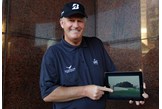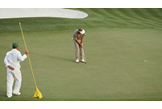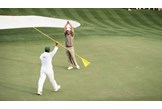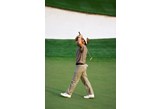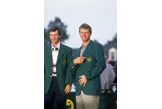Interview: Sandy Lyle
Published: Last updated:
I always had a good feeling about Augusta. I won the money list in Europe in 1979 and played pretty regularly there after that. It seemed a course you could acclimatise to fairly quickly. I had years when I made cuts and years when I missed them, but I always felt I had a good chance of playing well. Not being the most consistent player in the world, it seemed heaven to hit the odd wild shot and still find a good lie. It wasn’t super long – there were a lot of key decisions to be made about attacking the hole and where to put the ball on the greens. Obviously, putting was key, but going from playing the US Open and US PGA, where the fairways were narrow and they grew the rough good and thick. I thought: ‘I feel at home here; this is an easy golf course.’
The thing I had going for me in 1988 was that I’d won the Greensboro Open the week before. I was coming into the tournament on a high, but was aware I’d given everything to win. I was tired after the weekend’s tension and the Monday and Tuesday of the Masters was a sheer blast of interviews. It felt like a circus and my only peace was on the course.
In my mind it was just a case of staying in there. It was nice to get off to a decent start. You’ve had your 71 in the first round, but can still blow it with your second. I shot 67 and remember thinking: ‘You’ve done the hard bit and made the cut, let’s not throw it away’.
What I did very well was position the ball on the green. I didn’t put myself under any undue pressure to get up-and-down, or use my luck early. When I got myself in awkward spots I came through with flying colours.
Despite starting the last day with a two-shot lead over Ben Crenshaw and Mark Calcavecchia, the first time I really thought I had a chance of winning was at the par-3 4th. I was in a sticky position, through the green with a chip almost up against the 5th tee. I’d have happily taken four, but I chipped in for two and said to myself: ‘If you’re not going to win now…’
Then at the 9th, where the pin was in a really tricky position, I judged my 7-iron approach perfectly and left myself a two-foot putt.
Nine to play… Lyle birdies the 9th to go eight under, three ahead of Calcavecchia in the group ahead
With nine to go, it wasn’t in the bag, but it was where I wanted to be. Amen Corner was always in the back of my mind. The 10th and 11th were where I really wanted to do well; get some pars and then I’d handle whatever came my way on the 12th. I made par on 10, but I got a little mud on my ball after my second shot on 11 and I was a little concerned how it would fly; so I aimed my approach right at the pin and finished pin-high, but just a foot or so off the green, which was fine. When I got over the ball, however, I found there was still mud on it, enough to affect the roll. My next shot bobbled and stopped eight feet short. I missed the putt – my first hiccup.”
Seven holes left… Lyle is two clear at seven under after bogeying 11
The 12th is one of those holes. The wind can swirl around all over. You’ve just played the previous hole with the wind dead against but when you get on the 12th tee it feels like it’s right behind you. As it happened, the wind was gentle on the day, so that wasn’t a factor.
I saw Bernhard Langer tee off with an 8-iron and put it to the back of the green and I thought: ‘Well, if he can hit it to the back I certainly can.’ I was very comfortable, thinking the worst that could happen, if I was unlucky, was that I’d hit my Sunday best and end up in the back bunker. As it happened I probably hit the ball one rib lower on the club than I’d intended. The ball stopped for a while on the top, then rolled back about 15 feet into the water. Horrific.
Worse still, the next shot is even harder – either you tee it up again or you go up in front of the lake. I did the latter and tried to come in from 70 yards, but the green was rock hard. I hit the green about three feet from the pin, but couldn’t stop the ball and came away with a five.
I’d gone bogey, double bogey yet I felt I hadn’t done a whole lot wrong. I was very frustrated. I feared I’d blown my best chance. But deep down I thought: ‘I’ve lost a few shots but I’m still in the thick of it; I’m not behind, I’m still tying for the lead and I’ve got two par 5s coming up.’ The 15th is an eagle opportunity and 17 is a good birdie chance.
Six to play… Lyle is five under, now one behind Calcavecchia, who has birdied 13.
The 13th is a tough tee shot, particularly at this stage. I went fairly bold with the driver and slightly mistimed it, but it was a hooky shot, which was the best kind to play. It went whizzing round the corner and I only had a 7-iron to the green. I didn’t hit it quite as well as I’d hoped and the ball caught the crest of the green and spat down into the bunker. It was a horrid lie. At this point it felt like one thing after another… I played wide of the pin and managed to keep it on the green, just, two-putted and made par. But I felt that it was really a wasted chance.
I hit a good drive on 14 and a very nice, solid 6-iron, which got the ball within eight feet. That might not seem particularly amazing, but anything within eight feet with a 6-iron in your hand was good work at this stage. I had a decent chance of birdie, which I missed, unfortunately. On 15 I hit another good drive, not such a good second shot which just fell off the back of the green, but from there I almost chipped in – then missed a five-foot putt back for birdie…
Three to play… Calc and Craig Stadler share the lead at six under. Lyle is a shot back
So now I’m beginning to think to myself: ‘You’ve only got three holes to go, you’ve just missed chances that were playing relatively easy. It’s not looking good is it?’ It felt like desperation time. I was still one behind Calcavecchia. I hadn’t lost a heap of ground but it wasn’t a comfortable position. Being all-square with three to go, you can maybe make something happen, but being one behind with him having the momentum and the crowd, I began feeling a little out of place.
My tee shot on the par-3 16th wasn’t great. It was on line, but behind the pin around 20 feet or so, leaving a downhill putt with a lot of borrow. Late afternoon with the greens like a table top, I could quite easily see the ball rolling eight or nine feet past the hole. I’m seeing bogey here. So I just said to myself: ‘You’ve got to pick your line and get the pace as good as you can. You’ve got nothing to lose.’ I hit a good putt, but I still couldn’t tell within two feet to go. And then it dropped in for a birdie. The door was still open.
By now it was just me battling with the golf course and the elements. The week before was catching up and the legs were getting tired. Your adrenaline can only last so long. This was the ultimate in digging deep, because there was nothing left in the tank. My drives were getting a bit wishy-washy, they didn’t have the same crispness as in the early part of the week. I was just hanging in there, but I scraped my way to par on 17.
One to play… Calcavecchia is the new clubhouse leader at six under. Lyle needs a birdie to win the Masters
Actually I am thinking: ‘If only I can get a four here I’ll take my chances in the play-off.’ The next thing I see is my drive going into the bunker. I must have been pretty shell-shocked at this stage because I didn’t really think: ‘That’s it, game over.’ You never really know until you’ve got to the bunker and seen how the ball is lying. It had landed in the face of the bunker which wasn’t massively deep, but it was steep.
The good fortune I had was that it was just on the upslope, which makes a huge difference to your trajectory. I knew I still had a chance. I could probably have hit a 6-iron off the same lie but there were so many things going through my mind – if I got too cute I could nip the lip of the bunker and end up in the bunker just ahead; if I caught too many grains of sand I could end up in the bunker by the green, which wouldn’t give me much chance of getting near the pin. The right club was an 8-iron, but that meant striking it 100 per cent. With 145 yards uphill, which translates as 155 yards, I thought I’d rather hit it past the pin. Out came my 7-iron.
Of course, I couldn’t see the green or the pin. I lined up the shot using a cloud. When I hit the shot I thought: ‘That’s not bad, I’m quite excited.’ But when the ball landed the crowd didn’t react the way I’d expect them to if I’d hit a great shot. So I trudged up thinking I was right up towards the back of the green somewhere. Then I started hearing the growing murmur from the gallery as if something was happening. I pictured the ball rolling down the hill to around a foot, so I’d have a little tap-in, shake hands and go off for a cup of tea as Masters champion. When I got there I saw it was about 18 feet from the hole. It was a horrible putt to be faced with.
Then came the ongoing saga of Crenshaw, my playing partner. He was butchering the hole. He flew left off the tee, had to get the crowd to move, took ages to work out his yardage and then missed the green left. He had to move the crowd again before chipping onto the green, then asked to putt out before I did (finishing at four-under). I was thinking: ‘How long do I have to wait to hit this putt?’
But in hindsight, you don’t often get eight to 10 minutes to prepare for a key putt. I’m looking at every aspect of it, all the indents and spike marks, working out exactly how to play it. What the grain is going to do, trying to recall all the similar putts I’d seen on TV.
Deep down there was some calmness. I knew if I did miss, it wasn’t going to be the end of the world. I was mentally rehearsing Lee Trevino saying: ‘If I ever had a putt to win I’d rather have a downhill putt any day than have a 30-foot uphill putt where you really have to hit it.’ I felt that I’d gone through hell over the last hour-and-a-half to get within a shot of winning and two of making a play-off.
And I made it. I remember overwhelming relief. My dance of joy might have been a bit leaden-footed but at least I got in the air.
After a traditional dinner with the members of Augusta, I knew there was a disco at my parents’ hotel, so I thought we’d celebrate properly with the players, the caddies, the press. But it was dead; there were about nine people at the bar. Everyone had gone home except for Nick Faldo, who was doing some work for the BBC. He said congratulations, which was nice, but it was strangely anti-climactic.
The following day I left for Hilton Head. That’s where the real celebration took place. I took a big entourage of British press and the caddies out to dinner before the tournament and then the caddies put on a party as well.
Going back to Augusta still feels special. I’d say I’ve had someone come up and congratulate me on that bunker shot at least once a day for the past 25 years. As for the trusty Mizuno 7-iron, I gave it to the World Golf Hall of Fame in St Augustine, Florida, when I was inducted in May 2012.

